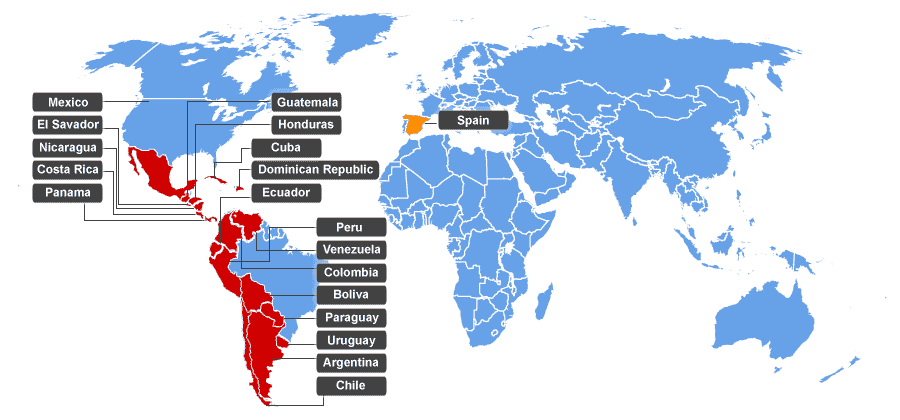
Why You Should Study Spanish as a Second Language
DATE:
In an age that places demands on people’s global knowledge, learning a second language has become increasingly necessary in order to gain a better understanding of worldwide events and open up to new perspectives that will make you an informed and responsible citizen of your country.
Studying a foreign language introduces you to new worlds of ideas, customs, habits, and values. When different cultures come into contact, they can create extraordinary opportunities for exchange, cooperation, and mutual benefit.
In this globalized world, international contacts are an important element of many occupations, and those who lack the ability and sensitivity to deal with other cultures are at a disadvantage.
Knowing a new language enriches your personal life, expands your professional opportunities, and strengthens your ability to act as a global citizen.
After considering all of the above you may be asking yourself, from around 6,500 languages spoken in the world, why Spanish? What makes it so special? Let us show you 5 reasons why choosing to learn Spanish as a second language would be beneficial for you.
Why learn Spanish as a second language?
1. Growing number of speakers
According to the Cervantes Institute Yearbook: Spanish in the World, in 2021, almost 493 million people around the world have Spanish as their native language, making it the second most spoken language in the world just behind Chinese Mandarin, and ahead of English.
The group of potential users of Spanish in the world (a figure that includes native language speakers, people with limited proficiency, and foreign language learners) exceeds 591 million, which would be 7.5% of the global population.
Even though Spanish is not an official language in the United States, it is the second most spoken language in the country with around 41 million native speakers and 12 million people who are considered bilingual.
In fact, according to recent Modern Language Association reports, Spanish is the most studied language in the United States, with about 50% of college students and 70% of K-12 students choosing to study Spanish in school.
Only in the United States, the popularity growth is becoming exponential and it is predicted that by 2060 the United States will rank second among Spanish-speaking countries after Mexico. And around the globe, the Spanish language is the third most studied language in the world.
2. Wide geographical spread

Spanish is recognised as the official language in 20 countries of the world, most of them located in the Americas
|
● Guatemala | |
|---|---|
|
● Bolivia |
● Honduras |
|
● Chile |
● Mexico |
|
● Colombia |
● Nicaragua |
|
● Panama | |
|
● Cuba |
● Paraguay |
|
● Peru | |
|
● Ecuador | |
|
● El Salvador |
● Uruguay |
|
● Equatorial Guinea |
● Venezuela |
But more than just being one widely spoken language in the world is its relevance. Spanish has been exceptionally influential and significant in the development of the modern world.
It’s the third most used language in the United Nations after English and French, fourth in the European Union, and first in American and Ibero-American integration organizations.
3. Career growth and new business opportunities
Learning Spanish as a second language is beneficial to conduct business and expanding services to new markets. Even in the United States Spanish has become a widely spoken language at work since most companies operate on a global scale, making bilingual employees a high demand in business.

Booming economies in Latin America are providing new career opportunities and a well-educated workforce you may strive alongside with.
Spanish and English are the most spoken languages in the region, so any cross-cultural effort for cooperation, sales, or negotiation will benefit from your experience in their communities and your skills in the Spanish language.
Learning Spanish as a second language enables you to understand another culture, explore new perspectives, and based on that, build new negotiating strategies.
This will demonstrate to your employers how innovative you are, giving you a competitive edge over other employees.
4. Many beautiful places to travel to
Latin America is a very popular travel destination nowadays. Many have even fallen in love with these Spanish-speaking countries and their culture.
You’ll find people around the world who speak Spanish as a second language because their dream is to make a living in a Spanish-speaking country.
Ready to travel? Let us show you all the wonders the Spanish-speaking countries of the world have to offer!
There are many reasons why people make this choice, among them: a more economical way of life, a less competitive market, and a less stressful political and social situation. Some others just want to find the love of their life or enjoy the weather, the friendliness of the people, the hospitality, and the amazing food.
5. Easier to learn
For English speakers, Spanish would be an easy language to approach for its related grammar structures and straightforward pronunciation.
Spanish is what we call a phonetic language: it sounds just as it is written and vice versa (with its respective grammar rules, of course). No changes in pronunciation because consonants and vowels sound as they are spelled and the only silent letter is the h.
As you may progress in your learning journey you will notice that many Spanish words are similar to their English translation. That is because English, even though it is considered a Germanic language, was also highly influenced by French which, like Spanish, is a Romance language, both their roots derived from Latin.
There are between 15,000 and 20,000 Spanish-English cognates, making it easy for English speakers to learn Spanish vocabulary quickly.
How can you learn Spanish as a second language?
Learning any language takes dedication and speeding up the process is completely up to you. But here we are going to present to you 5 of the most effective methods for you to learn Spanish as a second language
1. Find yourself an online tutor to speak with each week
Or you can also enroll in an online Spanish Academy course. Tutors should be qualified native Spanish speakers, that way certain details and expressions will be easily explained.
A tutor can help you improve your Spanish grammar and pronunciation as well as know your weak areas and put together an organized study plan customized to tackle them.

2. Speak and Listen to Spanish daily, from day one
Your language learning process can be accelerated by immersing yourself in a Spanish language environment.
Even if spending a few days with native speakers isn’t practical, you can still download Spanish learning apps, listen to Spanish music or podcasts in the vehicle, or watch Spanish soap operas without subtitles.
You won’t believe how easily an immersive experience may improve your ability to hear and interpret Spanish.
3. Read books in Spanish
While learning Spanish, literature can help you get more immersed in the language since it can present you with richer vocabulary and images that an instructor can’t provide.
For that we recommend you to start with books in Spanish that have shorter content, basic vocabulary, and use simple sentence structures. Progress according to your level of skills.
4. Write in Spanish
Like reading, writing in Spanish is as important in your language immersion process. Writing things down while listening, for example, can help you remember new words and phrases and how they are used in context.
This is considered an excellent approach to train your mind and motivate you to learn and use new terms.
Spanish fluency is acquired by thinking and acting like a native and what better to start if not by reading and writing in it?
5. Join a language learning community
Lack of motivation is a common struggle for many people who are learning languages. Sometimes you believe the bar is set too high or feel you are alone in the process, and that is why joining a learning community is very important (may it be offline, online, or on social media).

When you surround yourself with others who are on the same journey, you will be able to support and encourage each other in pursuit of a common goal.
In an online learning community, you may find Spanish native speakers who are eager to help people with their pronunciation. You can also find others sharing tricks and hacks to effectively learn certain grammar traits, and fun games to either consolidate your vocabulary or learn new ones.
By joining a learning community you can achieve great results.
Struggle points while learning Spanish as a second language

1. Diverse dialects
There is a wide variety of dialects because Spanish is spoken in so many countries. However, the differences aren’t so hard for Spanish learners.
There are 8 different dialects in Spanish: castellano, andaluz and canario in Spain only. In America, we have caribeño, mexicano-centroamericano, andino, chileno and rioplatense.
Depending on the geographical or even social environment, several more differences can be found providing odd characteristics in pronunciation, grammar, and vocabulary.
Out of the three main characteristics differentiating Spanish, vocabulary is the one having the biggest role. You’ll be able to understand words but they can sometimes be tricky.
Is this a real obstacle? Not really.
The Spanish as a second language program is meant for students to be exposed to this great dialectal variety during their learning journey. This is in case a student doesn’t know where his/her Spanish is going to be used.
When students decide the country in which the language is to be used, it’s much simpler. If it’s private lessons, ask your online teacher what you need.
You are not going to learn all the vocabulary. Even native Spanish speakers won’t understand some expressions when employed by other Spanish speakers from another country until some context is provided.
And context IS necessary so you don’t misunderstand words. In Spanish slang language, a term may mean one thing in a country and yet a completely different thing in another.
2. The You pronoun in Spanish
Some English speakers may have a problem at first learning Spanish with the distinct ways we use the pronoun “you”.
The pronoun “you” is utilized for singular and plural in English but not in Spanish. In Spanish, there are 5 different personal pronouns.
We have 2 for the informal singular way tú and vos which are used everywhere in Spanish-speaking countries. Tú is the most international and the one you’ll listen to frequently. Vos is also commonly spoken in certain regions of Spain and South America. Even though it sometimes coexists with tú, when it comes to.
Using vos is called voseo
On the other hand, we have usted for the formal singular way. Use it with people you don’t know well, who are older than you, or even with those who have a higher position, sometimes.
Ustedes and vosotros are both for the plural “you”. These are way easier because of the geography separating the terms.
As an interesting Spanish fact, Ustedes goes all across Latin America and vosotros only in Spain.
3. Gender and number agreement in Spanish
Another feature of Romance languages like Spanish is that nouns (including those denoting non-living things and abstract concepts), adjectives, and verbs change depending on gender and number, something that English speakers are not familiar with.
Of course, there are certain rules to follow and their respective exceptions, but unfortunately, some of the vocabularies has to be learned by memory.
4. Spanish is as easy to forget as it is easy to learn
An easy language to approach as we have stated indeed. But still, learning Spanish, just like any other new skill, requires effort and commitment.
Spanish learners often tend to think that since English isn’t that dissimilar then they don’t have much to learn, so they put in a lot less effort than they would when learning more “difficult” languages. But the trick when learning a second language is to be consistent in your studies.
People must create a habit of learning the language every day if they plan to stick with it over time: constantly reviewing lessons after class, vocabulary, immersing themselves in a Spanish-speaking environment to put it into practice, watching Spanish TV shows, listening to podcasts in Spanish, music, etc.
By strengthening your language training program with a proper study habits you will be able to make sustainable progress and speak Spanish in no time.
Spanish as a second language certification

The Diplomas de Español como Lengua Extranjera (DELE) is the official certification provided by the Instituto de Cervantes of Spain which evaluates the knowledge a person has in Spanish as a second language.
The six levels of qualification correspond to the levels described by the Common European Framework of Reference for Languages:
- Diploma de Español (Nivel A1): The person can communicate using basic expressions to satisfy specific needs, to ask questions about personal information, and interact a little as long as the other person speaks slowly.
- Diploma de Español (Nivel A2): The user has sufficient linguistic ability to understand frequently used expressions in areas such as family information, shopping, local geography, and employment. The user can also talk about routine tasks and describe simple matters.
- Diploma de Español (Nivel B1): This qualification accredits the person who can understand texts talking about work, studies, or everyday life not using local jargon. The person can also write and talk about these topics.
- Diploma de Español (Nivel B2): The test taker understands main ideas in complex texts containing specialized use of the language that is related to the person’s field of study. Also, interaction with Spanish speakers doesn’t cause any understanding issues. Production of texts is detailed in a wide range of subjects.
- Diploma de Español (Nivel C1): Understands and can write longer and more demanding texts without the need to do too much research. Expresses ideas fluently in social, academic, and professional situations without noticeable efforts to find words.
- Diploma de Español (Nivel C2): Certifies sufficient linguistic skills to understand almost everything read or heard with ease. The language user can summarize information from different sources into a single well-sustained presentation. The user can also perfectly handle complex situations with spontaneity proving a fine capacity for adaptation. Students with C1 and C2 qualified levels are considered bilingual.
Learn all the important facts before taking the DELE exams with our guide on DELE prep courses.
Final Thoughts
Choosing an online program with teachers who have Spanish as their native language is highly recommended. Learners should focus on asking a lot and getting as much vocabulary as possible.
If you decide to study a second language, Spanish is a great option. Try a free 1:1 class or sign up for a free 7-day trial of our group classes to see how thousands of students are dominating the Spanish language with SpanishVIP.








